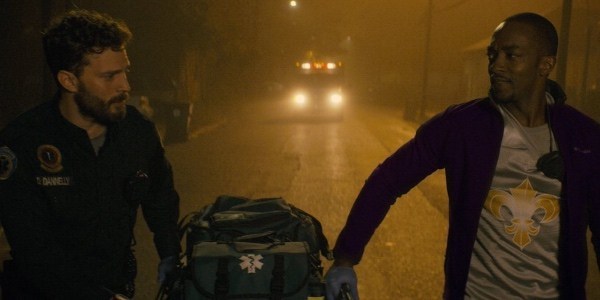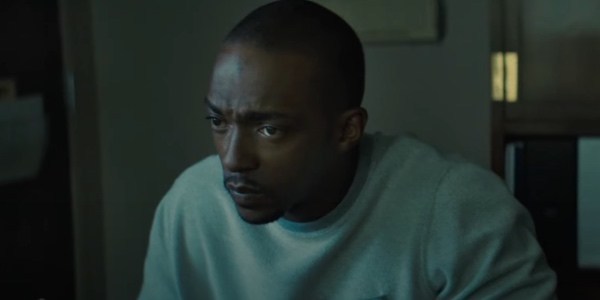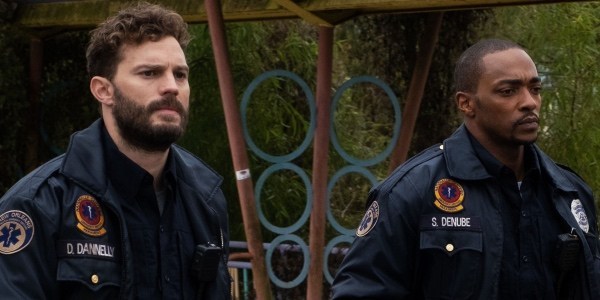SYNCHRONIC: A Bumpy Trip Through Time
Synchronic, from directors Justin Benson and Aaron Moorhead, is a film you don’t realize has your attention until you find yourself struggling to look away, to hear the world around you. Like a drug, its effects are slow, building into an experience. And like with drugs, whether that experience is good or bad will depend on the user. Synchronic is a film that threatens to work for some, yet will fall to the wayside for others.
“Time is a Lie”
The illusion of time and its malleability in the minds of humans and space has been a theme many filmmakers have tackled. From black holes to delorians, time is a construct meant to be broken, traveled, and understood. Synchronic is the latest film to tackle time, its construct defied by the simple ingestion of a little pill. Yet, as with most time travel, its manipulation is meet with hostility and violence, the universe fighting back against our increasing knowledge and warped understanding of time.

Local New Orleans EMTS, Steve (Anthony Mackie), and Dennis (Jamie Dornan) are the first to come face to face with the devastating effects of Synchronic, its victims left wounded and dismantled, many times without reasonable explanation or understanding. This is like nothing they have seen before. Yet, as more and more people fall victim, their definition as first responders begins to alter as their personal lives and the line of duty become one in the same.
A film with its ups and downs
Synchronic will certainly capture and mostly maintain the attention of its audience. Its perspective on the manipulation of time through pharmaceutical drugs and its effects on the brain brings an interesting element to the study of time through film. Yet, where Synchronic falters is in its lack of attention towards the drug itself, too often feeling as it is a story more concerned with conversations between characters. While it can be debated much of the conversation is needed to build empathy for Synchronic’s characters, unfortunately when contrasted to the unimaginable effects of the pill and bodies piling up, it dulls in comparison – many times causing the film to drag.
Also Synchronic seems unsure of who its focus is supposed to be about. It feels as though the film should be primarily focused on Steve. He is fighting brain cancer, attempting to maintain a normal life, each element of his silent struggles adding to his willingness to test the boundaries of the time he has left. His lack of restraint and increased compulsion is a focus the film does touch upon, yet leaves plenty of room to have leaned into it even more heavily. By the film’s end, it felt as though, while grazed upon, Synchronic missed an opportunity to tackle the struggles and concept of accepting death, coming to terms with the life we have left and the one we leave behind.

Rather, Synchronic interjects and distracts from its central character, attempting to reconcile its need to make this a duel led film. There are scenes of Dennis with his wife, their interactions, and struggles. While this is to build his home life and relationship with his daughter, this could have been established through phone or face conversations with his wife, daughter, and Steve. His extra exposition takes away from his partner’s story, struggle, and the meaning behind the catharsis he brings to the story.
Not all is lost
While this review lends itself to negativity, Synchronic has a lot of redeeming qualities that make the film overall entertaining. The settings of New Orleans were perfect, overlooked areas tourists rarely visit and cameras do not capture given a moment of perspective. Especially intriguing was the use of the former Six Flags which was rendered condemned following the devastation of Hurricane Katrina years earlier. There is a reclamation time has allowed the earth to take the land back, overgrowth weaving in and out of the rollercoasters and the buildings. This reclamation mirrors placing a needle within a moment of time, placing many back into the memory of devastation and destruction.
Building off of the scenery and setting, the film expands beyond what the characters can touch, heightening the idea of time. One of the most attention-grabbing moments in Synchronic is the placement and structure of its clouds. Filmed as rings in the sky, rippling from its center, it displays not only the effects time can have on the future, but also gives a foreshadowing to the watered-down explanation of the pills functionality on the human brain and time itself.

The film also excels in its tension. It is a slow set-up at first, pieces laid in place to build upon as the film continues. The gore is also perfectly balanced. Never too over the top, fitting just the mood and tension the film is attempting to create. Synchronic also excels with an established set of rules that carry through the film, ones that heighten the intensity and the danger of taking Synchronic presents. Giving the film a solid structure to maneuver around, this further heightens the tension on screen.
Conclusion: Synchronic
For all its faults, the ending of the film is deeply engaging – almost hypnotizing. While predictable, viewers will find themselves holding their breath in anticipation of how it will all end. While Synchronic is not the deep and pensive film it attempts to be, it is still an enjoyable film that will entertain.
Have you seen Synchronic? What do you think? Let us know in the comments below!
Synchronic will be released in theaters and drive-ins on October 23, 2020.
Watch Synchronic
Does content like this matter to you?
Become a Member and support film journalism. Unlock access to all of Film Inquiry`s great articles. Join a community of like-minded readers who are passionate about cinema – get access to our private members Network, give back to independent filmmakers, and more.
Join now!





